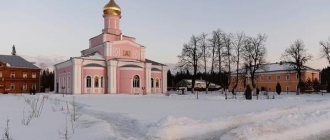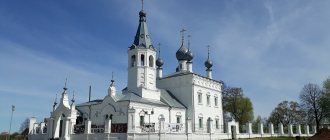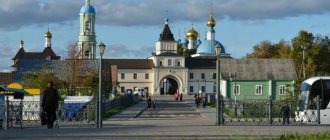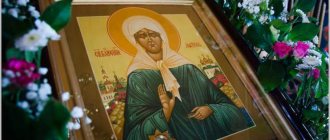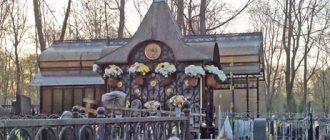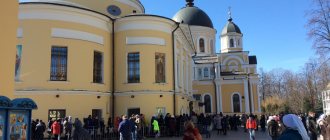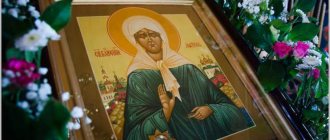St. Matrona Moscow
Pokrovsky Stauropegic Convent
Almost all believers who learn about Saint Matronushka for the first time are interested in the question -
how to get to the relics of Matrona of Moscow?
People have a very strong desire to personally visit the righteous old woman and ask her for help. After all, many remember her words: “Everyone, everyone, come to me...”
I must say that once you are in the city of Moscow, you can easily drive to the relics of the Holy Blessed Matrona of Moscow. The Pokrovsky Women's Stauropegic Monastery at Abelmanovskaya Zastava (Church on Taganka) has been the permanent location of this shrine since 1998. As pilgrims say, when they enter the monastery, their soul immediately becomes calm and joyful. People come here from different parts of the country to venerate the relics of Blessed Matrona, bring fresh flowers, pray and ask for help.
At the entrance to the monastery territory you can see the Church Bench. It is open daily (opening hours from 8.00 to 20.00). Here you can buy icons of St. Matrona of Moscow from the smallest to the largest church icons, books, church oil, candles, church utensils and much more.
Entrance to the monastery territory
Church shop of the monastery
Bell tower on the territory of the monastery
Near the entrance to the monastery there is a bell tower, and a little further there is a Holy Spring (or water-sanctuary chapel). Pilgrims can collect holy water here in their own bottles or in bottles purchased at the monastery. It must be said that there is a refectory on the territory of the Intercession Monastery, which is open to everyone. There is a small children's playground.
But, of course, the main place where all pilgrims go is the temple, in which the relics of St. Matrona of Moscow are located in a special tomb (reliquary). The shrine never leaves the Intercession Convent and is available to believers every day. Queues form from early morning until late evening. Another line is lined up for the large icon of Matronushka in the form of a fresco on the wall of the temple, right on the street.
Holy spring of the monastery
Icon on the wall of the temple
Recreated cross of the necropolis
How to get to the relics of Matrona of Moscow
Pokrovsky Convent (Church on Taganka) is located at the address: Moscow, st. Taganskaya 58. You can get to it by public transport, for example, by metro.
Directions: to the metro station “Marksistskaya” , exit to the street. Taganskaya. Then you can walk to the monastery (15 minutes) or by any transport (bus, trolleybus) to the Bolshaya Andronevskaya stop.
Directions: to the metro station “Krestyanskaya Zastava” or “Proletarskaya” , and then 10 minutes walk to Abelmanovskaya Zastava Square.
Visiting hours
Pilgrims can visit the relics of Matrona of Moscow daily. The opening hours of the temple where the tomb is located are the same as those of the Pokrovsky Convent. Visiting hours: Monday - Saturday from 07.00 - 20.00, Sunday from 06.00 - 20.00.
You can also attend morning or evening services in the temple. Read the schedule of services in this section.
Driving directions
(from the website of the Intercession Monastery):
Visiting Mother Matrona
According to the calendar it is spring. And it’s autumn outside. Damp, cloudy, spring snow lies matted, shaggy, covered with a crusty dirty crust. I'm going to Matrona. Either ask or thank. Don't know. The soul just demands that’s all. The words of my mother, spoken, according to eyewitnesses, before her death, sank into my soul: “Everyone, everyone, come to me and tell me, as if alive, about your sorrows, I will see you, and hear you, and help you.”
Yes, that's probably what I come for.
Talk it out. Not afraid to repent of your revelation; without fear of being judged, they will blab; They will not forgive weakness and will also betray you (a bad example is contagious!). Speaking out and being heard is a rare opportunity in our time of mobile communications. When you can “connect” with anyone, anytime, but have a heart-to-heart conversation with practically no one. I remember an expression from some book - probably a saying: “A friend only in good weather.” There are so many such “friends”. But today my soul is cloudy. So, we need to go to Mother Matrona... To talk it out. Find support and help. Even if he is guilty a thousand times. The pointed bell tower rose up like a cross. The line was longer than in winter. By summer, we'll probably be standing for two hours again. That is OK. I read the Akathist, and time flies by: “An angel in the flesh appeared on earth, the blessed Matrona, doing the will of God.”
In general, I like to read the akathist already inside, in the church, when I approach almost the very shrine with the relics: without going behind the twisted iron partition separating the left aisle, you can stand to the side - to the left of the line - and read. Many people do this. But I always start reading the akathist on the street, and in church I just finish reading it. To stay a little longer with my mother, but not to abuse this opportunity. Look how many people there are! Someone, like me, holds a thin book - an akathist to the saint - and carefully turns over the pages, trying not to wrinkle or drop the bouquet.
Eh, I forgot to buy flowers! I don’t know where this tradition came from, only every second person stands with a bouquet. The nuns bless the flowers on the relics and distribute them to everyone. How many times have I received as a gift either cut buds of roses and carnations, or branches of some plants. This time, for some reason, I really want to bring Matronushka flowers herself. But the line is moving quickly... I look around, wondering. I'm afraid I won't have time. Again I buried myself in the book: “Seeing the people and the priest, when you baptized you, blessed one, the wonderful pillar of cloud over your head and smelled a great fragrance...” I muttered mechanically: “fragrance,” and an annoying thought was spinning in my head: “Flowers, flowers, well, at least I wish I had one flower!” But then the queue will have to take place from the very tail. How much time will I lose! Idea! I'll change places with someone now. I walk along the line and take a closer look: I want to choose someone who also needs it - to go through quickly. Here: in the middle of the line stands a young mother with her son. He happily agrees to my proposal. We're almost running. We made it – almost at the very entrance to the Intercession Church, where the relics rest. Now I’ll tell you in my new place that I’ll be leaving for a while. I remember: standing behind me is a young woman with a bouquet of pale cream roses. These are the only ones I remember. I'm running for flowers. They say Matronushka loves the field.
So, red carnations or yellow chrysanthemums?
I must say that I don’t like either one or the other flowers, but these are the only “field” flowers. I haven’t seen daisies in Moscow. But these chrysanthemums seem to be splashing with color: such small radiant suns on green stems. I really liked them. I'm running back. I can't find the queue. I didn’t remember the woman’s face at all. Only pale roses in her hands and a fluffy fur collar. Yeah, here it is. No. I was wrong. And suddenly: “You were standing here, here.” Well, thank God! I'm making my way. And suddenly I notice that my neighbor, it turns out, has two bouquets in her hands: in addition to those very pale roses, there are brighter and, in my opinion, prettier ones - light pink. How did I not notice them before! It’s curious, before this I often saw people in line with several bouquets - sometimes luxurious, sometimes modest. And I always wanted to ask: why two (three)? Like me, we couldn’t make a choice: chrysanthemums or carnations, red or pink? Or in gratitude based on the number of requests fulfilled? This time, when an irrational feeling drove me to buy flowers, I’ll still ask...
“They asked me to pass it on,” answered the neighbor. – A girl came up and gave the bouquet; Apparently she was in a hurry - she didn’t explain. She simply asked to be placed with the relics.
– She came up when I was buying flowers?
- Yes, right after you left...
An interesting coincidence! This time I really wanted to come to Matronushka with a bouquet, and then a girl with flowers came up to us in line. Had I hesitated another minute or two, and the bouquet, apparently, would have been handed to me. Against my will, I break into a smile. Here's how. When you really want something. From the heart. Something very good. It's coming true.
Now it reads much more meaningfully: “Rejoice, fragrant flower, who makes us fragrant with the Holy Spirit; Rejoice, rock of faith, strengthening the faint-hearted in piety.”
It got warmer and the sun came out. So we went into the lower church of the Intercession Church. They sing. Only this is not an akathist! There is a service in the central aisle. How many times have I been to Matronushka’s, but I haven’t gotten to work here. The patronal feast, it turns out, is in honor of St. Jonah. Anointing. I'll be on duty. I’ll finish reading the akathist later. I step aside so as not to disturb those who continue to move towards the shrine with the relics of the saint. The service takes a long time. I'm standing right next to the salt. A little away from the open doors of the altar. Beyond them is paradise, so they say. When the doors of the altar open, the heavens open. The cloud that has descended on the soul is gradually dissipating. They tell you to light a candle. And I have flowers in my hands. The petal rays are no longer so perky... They will wither by the time I get to Matronushka. Not good... I really wanted to give a gift! Well, maybe we should put them in the nearest vase - next to the Kazan Icon of the Mother of God? Matronushka won’t be offended by me... I’ll bring it for her next time...
The service is over. I join the queue for the relics again. A woman stands nearby with a branch of luxurious tiger orchids! Wow!
- Thank you for something? – a tactless question involuntarily burst out.
- Yes! – the woman smiles happily. He turns away, then suddenly leans towards me and joyfully says:
“I helped, although I didn’t even ask.”
- Like this? - I ask.
- Well, I didn’t ask for myself. As always - for the family. Everyone has so many problems! You forget about yourself. And I coughed for a year and a half. Inexplicably. I’m tormented: medications don’t help, doctors don’t understand. I went to a homeopath, and only these “balls” saved me. And on the day that Matronushka was visiting, I ran out of medicine. And I only realized a day later, in the morning, that I had to go buy some. And suddenly I realize that there is no cough! It just happened by hand. That's how my mother helped me!
Her smile made my soul feel completely good. Helps! Even if you don't ask. Gives what is needed. You just need to have faith. Sincere and pure. And be grateful. Learn to give thanks. At least for all the good things. At first. And then – I’ve felt this before – we come to the temple, like to a supermarket: “Lord, I want this, this and this. And more. And quickly. Please!"
And there they see what we need most. And they probably give it to those who can understand and accept this gift. “Having from God the gift of insight from childhood, blessed mother, you have guided the hidden hearts of those who come to you, and the future, like the present one, has guided many people on the path of piety.”
Cancer with relics. Mother Matronushka, “with my soul standing in heaven before the Throne of God, my body resting on earth, and with the grace given from above, exuding various miracles. Look now with your merciful eye on us sinners..."
Here are these important words that I loved - above the shrine itself: “Everyone, everyone, come to me and tell me, as if alive, about your sorrows, I will see you, and hear you, and help you.”
And this time, more clearly than ever, I felt that you were “invisibly present” and listening to us. Everyone... But after all the events of today, there was no desire left to stand on the sidelines and talk about what was painful. Let go. God bless!
I'm leaning over cancer. Mother, bless!..
And I hastily step aside - to the “flower girls” - that’s how I mentally dubbed the girls distributing flowers consecrated at the relics of Matronushka... And in my hand there appears a sprig of small yellow “suns”. Exactly like those radiant chrysanthemums that I liked so much in the store...
Thank you, Matronushka!
“Rejoice, reliever of our sorrows; Rejoice, comforter in sorrows..."
History of the monastery
“On the Poor Houses” was the original name for the monastery, founded at the cemetery of wanderers. Here were buried those who had no relatives or friends, and therefore did not deserve to be buried with dignity. There were similar “Houses of God” for the poor and homeless in many Russian cities. Often they didn’t even have a church. But Moscow was lucky: not just a temple arose here, but a monastic monastery founded by the tsar himself.
In 1633, on the Feast of the Intercession, Moscow Patriarch Filaret, the father of Tsar Mikhail Feodorovich, died. Being a former boyar Theodore Nikitich Romanov, he not only headed the Russian Church, but, having extensive political experience, helped his son Mikhail.
In many ways, the country owes it to Filaret for overcoming the consequences of the Troubles of the early 17th century. Knowing well that deeds of mercy are no less useful to the soul of the deceased than prayers, the sovereign decided to build a men's monastery in the pilgrim's cemetery, dedicating it to the Protection of the Most Holy Theotokos. Thus, “in the Poor Houses,” monastic prayers began to sound for the departed “under the protection of the Mother of God and in the shadow of the Cross.”
Mikhail Fedorovich and his immediate heirs cared a lot about Pokrovsky. In 1655, under the royal care, a stone cathedral was built; from the beginning of the 18th century, the Church of the Resurrection of the Word and a high bell tower appeared. However, the special attitude of the sovereigns did not always guarantee prosperity. Thus, from 1680 to 1731, Pokrovsky was considered attached to the Zaikonospassky Monastery - due to poverty and a small number of inhabitants. The monks did not easily survive the capture of Moscow by Napoleon (1812). The buildings were occupied by French soldiers. They plundered and devastated the already poor churches. Only by the middle of the 19th century was it possible to restore the walls and gates. In 1855, the Church of the Resurrection of the Word was rebuilt (the author of the project is the architect M. Bykovsky).
Since the 1870s, Pokrovsky became a missionary center; courses were opened for monks who wanted to spread the Christian faith among pagan peoples. The initiator of the good deed was St. Innokenty of Moscow, however, after his death (1879) the project was not continued. Therefore, by the beginning of the 20th century, Pokrovsky was not known for his social service or mission. As in the 17th century, Muscovites knew it primarily from the most famous necropolis.
How to get to the relics of Saint Matronushka
Holy Mother Matrona of Moscow was born in Russia in the last century completely blind, but this did not stop her from becoming known for her Godly gifts throughout the world and helping Orthodox Christians with prayer and advice. After the death and canonization of the relics of the Matrona of Moscow, they were transferred to the Intercession Convent, which today is named after the Holy Matrona of Moscow, to the left side chapel of the Intercession Church of the Blessed Virgin Mary.
How to get to and venerate the relics of Matrona of Moscow, as well as what pilgrims need to know, is described in this article.
Who is Matrona of Moscow:
Cemetery
By the 19th century, famous residents of the capital, philanthropists, and honorary citizens began to be buried here. There were many graves of church hierarchs, monks, and priests. Pokrovskoe cemetery became the largest in the city. Its area was 5.4 hectares. Among those buried here:
- creator of a grammar of the Yakut language, missionary, Bishop Dionysius (Khitrov);
- poet D.P. Glebov;
- banker, local historian, philanthropist N.A. Naydenov;
- merchant, patron of art, collector of ancient manuscripts A.I. Khludov, other representatives of this Moscow family;
- famous entrepreneurs, Botkins.
In total, more than 3,000 burials are known at the beginning of the 20th century. Almost all of them were destroyed after the abolition of the monastery by the Soviet authorities (1929).
Destruction and rebirth
The cemetery, known to all Muscovites and preserving the memory of the city's past, was completely destroyed in the 1930s. Erasing the memory of the famous Muscovites buried here, a cultural and recreation park of the Zhdanovsky district (now Tagansky Park) was built in its place. As for Pokrovsky himself, he lost his fence, and the churches were occupied by Soviet institutions.
Only in 1994 did the complex process of reviving the monastery begin - now as a monastery. The first liturgy in the dilapidated cathedral was celebrated in the fall of 1995. Eyewitnesses recall that the iconostasis with paper icons was made by the brother of the abbess Feofaniya, priest Alexander.
A few years later, the temples were returned, as well as part of the land not occupied by Tagansky Park. The destroyed necropolis that was located on this site is still a painful topic for sisters and parishioners.
